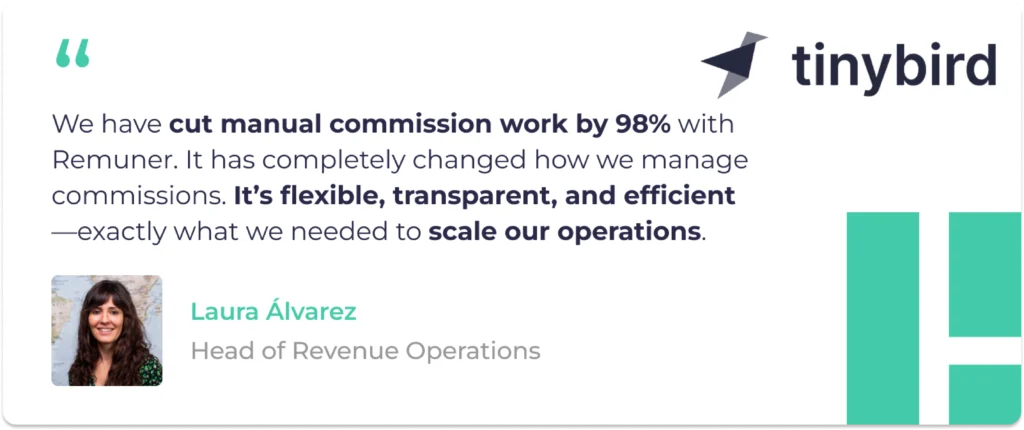Table of contents
What is Revenue Operations?
Revenue operations (RevOps) is a cross-functional team and framework that integrates sales operations, marketing operations, and customer success operations under a single strategy. This structure aligns systems and processes to reduce inefficiencies and help every team make informed decisions based on real-time, accurate data.
Core functions of RevOps Team:
- Creating a unified go-to-market motion
- Streamlining handoffs across the customer journey
- Standardizing KPIs, tools, and terminology
- Designing scalable compensation plans
- Empowering sales teams through enablement and insights
Why companies need revenue operations now
Buyers expect seamless, personalized experiences —and misaligned teams struggle to deliver. According to McKinsey’s research on growth marketing and sales, companies that break down silos see significantly higher revenue efficiency. When internal teams are misaligned, those expectations go unmet. Siloed data, inconsistent KPIs, and tool fragmentation lead to lost deals, inaccurate forecasts, and stalled growth.
RevOps eliminates these issues by:
- Standardizing sales enablement across the funnel
- Creating accountability between sales, marketing, and customer teams
- Connecting sales performance to real business outcomes
- Boosting win rates with real-time pipeline intelligence
- Supporting better sales incentives and quota design
RevOps is not just about efficiency. It’s about enabling growth through synchronization.
The Role of RevOps in Compensation Planning
One of the most strategic functions of a revenue operations team is designing and managing compensation structures that drive performance. Misaligned comp plans can lead to:
- Reps chasing unqualified leads
- Internal disputes over payouts
- Inconsistent motivation across the team
RevOps responsibilities in comp planning:
- Aligning comp plans with company goals
- Ensuring OTE (on-target earnings) is competitive and achievable
- Tracking attainment metrics to calibrate incentive effectiveness
- Modeling payout scenarios and performance trends
- Automating reporting and dashboards
Example:
A mid-size SaaS company realizes its reps focus too much on new logo acquisition but ignore expansion revenue. The RevOps team redesigns the comp plan to reward upsells. Using Remuner, they implement the new model in minutes, enabling accurate tracking across cohorts.
RevOps-driven compensation isn’t just about fairness—it’s about retention. Companies using RevOps-aligned comp plans see 36% lower sales rep turnover (Pavilion, 2024). By tying incentives to clear, achievable metrics, RevOps reduces frustration and keeps top performers engaged.
💡 Many professionals still misunderstand what being a RevOps leader truly involves. While some perceive the role as purely operational or data-driven, the reality is far more nuanced. In a recent Forbes article, members of the Forbes Business Development Council debunk common myths—such as RevOps being “just another tech role”—and highlight the strategic nature of the position.
From aligning go-to-market teams to driving revenue predictability, RevOps leaders are increasingly seen as architects of scalable growth. This insight reinforces why organizations must position RevOps as a strategic partner, not a support function.
How to Build a High-Performing RevOps team
If RevOps is your growth engine, the revenue operations team is your pit crew. Their role is to integrate tools, enforce consistency, and provide strategic insights.
Key roles in a RevOps team:
- RevOps Manager/Director: Sets the strategy, prioritizes initiatives, and manages the tech stack
- Sales Operations Analyst: Focuses on quota, performance dashboards, and CRM hygiene
- Marketing Ops Specialist: Manages campaign attribution, lead scoring, and funnel reporting
- Customer Success Ops Lead: Owns retention data, onboarding metrics, and expansion tracking
- Compensation Analyst (optional): Designs, implements, and monitors comp plans
This cross-functional team ensures that performance isn’t just measured—it’s enhanced.
RevOps and the evolution of compensation strategy
Before RevOps, compensation plans were often created by finance or sales leadership alone. The result? Misaligned KPIs, unrealistic OTE, and misfired incentives.
Now, RevOps brings a data-driven approach to compensation.
RevOps introduces:
- Benchmarked quota planning using past performance and territory data
- Incentive modeling across different pipeline stages
- Forecasting impact of comp plan changes
- Real-time visibility into sales incentives and earnings
Platforms like Remuner simplify this process. You can simulate comp plans, identify outliers, and adjust incentives to match your business model—all without manual spreadsheets. Book a free demo here!
“The data proves RevOps works: Companies with RevOps see 19% faster revenue growth and 15% higher profitability (Forrester, 2023). When sales, marketing, and customer success share goals and data, revenue becomes predictable—not accidental.”
Best practices for implementing revenue operations
RevOps is not just about structure. It’s about cultural alignment and disciplined execution. Here are proven strategies to succeed:
1. Start with a unified data model
Align your CRM, comp platform, marketing automation, and support tools under a single data framework. This ensures shared definitions and metrics across departments.
2. Focus on the customer journey
Build systems and incentives around lifecycle stages—from awareness to expansion. Avoid isolated goals that break continuity.
3. Automate performance visibility
Use tools like Remuner to automate compensation dashboards, forecast attainment, and track rep behavior.
4. Iterate regularly
Comp plans, tech stacks, and team KPIs should evolve with market conditions. Quarterly comp reviews led by RevOps ensure agility.
5. Enable cross-functional feedback
Create shared Slack channels, weekly huddles, or dashboards that allow sales and customer success teams to weigh in on what’s working—and what’s not.
If you want to learn more about RevOps best practices read the article.
Real-life examples of Revenue Operations Success
Tech startup with poor attainment
A startup had less than 40% of reps hitting quota. The RevOps team benchmarked OTEs, rebalanced territories, and introduced a ramped comp plan. Result: 68% of reps hit quota the next quarter.
Mid-market fintech with comp disputes
Reps complained that earnings were inaccurate. With Remuner, the company automated all payout logic, introduced rep-level dashboards, and reduced comp complaints by 75%.
Global SaaS firm scaling CS incentives
Customer Success lacked variable comp. RevOps added net revenue retention incentives and aligned them to expansion goals. NRR rose from 108% to 122% YoY.

How RevOps influences sales performance
Sales performance is a direct output of clarity, enablement, and fair incentives. RevOps connects these dots.
By combining sales enablement, transparent goal-setting, and proactive coaching tools, RevOps:
- Improves rep onboarding by 30–50%
- Increases win rates through cleaner pipeline insights
- Shortens sales cycles with aligned messaging and expectations
- Boosts revenue generated per rep through smarter comp levers
Tools like Remuner are essential in this phase. They reduce noise, create payout transparency, and allow RevOps to scale without burning out the team.
Compensation is the #1 lever for driving behavior. If your comp plan isn’t tied to RevOps data, you’re guessing—not scaling.’
—Mark Roberge, Former HubSpot CRO & Author of The Sales Acceleration Formula
Scaling revenue operations: When and how
When to build a RevOps function:
- Sales headcount > 10
- Frequent comp plan changes
- Inconsistent quota attainment
- Reporting errors or manual payouts
- Siloed data between sales, marketing, and CS
How to scale effectively:
- Centralize tools around RevOps
- Hire or designate ownership roles
- Use Remuner to integrate compensation into your GTM engine
- Set quarterly OKRs tied to revenue impact, not just activity volume
FAQs about Revenue Operations
What is revenue operations?
Revenue operations (RevOps) is a strategic approach that unites sales, marketing, and customer success under a shared structure to drive predictable and scalable revenue.
What does a revenue operations team do?
The team aligns tools, processes, and goals to support the full customer lifecycle. They handle everything from lead attribution to comp planning to customer retention tracking.
What’s the difference between RevOps and sales ops?
Sales ops focuses solely on sales. RevOps spans all go-to-market teams and manages how each function contributes to revenue generated.
How does RevOps impact compensation?
RevOps brings a data-driven approach to compensation by aligning incentive plans with company goals, modeling plan impact, and tracking performance metrics.
When should I implement revenue operations?
If you’re experiencing quota inconsistency, misaligned comp plans, or reporting errors, it’s time to consider RevOps. Most companies benefit once they reach ~10 reps or have more than one go-to-market motion.
Can RevOps improve sales incentives and performance?
Yes. By modeling, measuring, and iterating comp plans, RevOps ensures that sales incentives truly drive desired behavior and increase sales performance.





